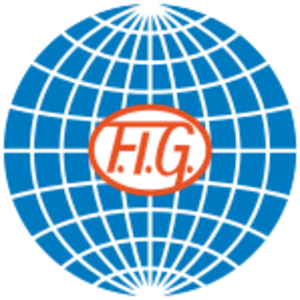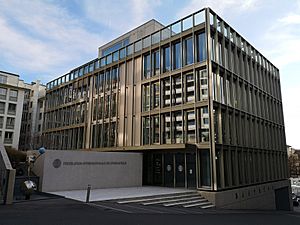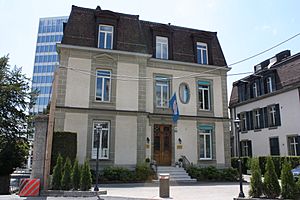International Gymnastics Federation facts for kids
 |
|
| Abbreviation | FIG |
|---|---|
| Formation | 23 July 1881 |
| Founded at | Liège, Belgium |
| Headquarters | Avenue de la Gare 12 |
| Location |
|
|
Region served
|
Worldwide |
|
President
|
Morinari Watanabe |
| Affiliations | Longines, VTB, Cirque du Soleil |
|
Revenue (2019)
|
US$17.32 million |
| Expenses (2019) | US$16.19 million |
The International Gymnastics Federation (often called FIG) is the main group that controls all the different types of gymnastics competitions around the world. Its main office is in Lausanne, Switzerland.
FIG was started on July 23, 1881, in Liège, Belgium. This makes it the oldest international sports organization still active today! When it first began, it was called the European Federation of Gymnastics. Only three countries were members: Belgium, France, and the Netherlands. In 1921, countries from outside Europe were allowed to join, and that's when it got its current name.
The FIG creates the rules for how gymnasts are judged. These rules are known as the Code of Points. FIG oversees seven main gymnastics sports:
- Artistic gymnastics (for both men and women)
- Rhythmic gymnastics
- Aerobic gymnastics
- Acrobatic gymnastics
- Trampolining (which includes double mini trampoline and tumbling)
- Parkour
The federation also decides how old gymnasts must be to compete in big events like the Olympics.
After some world events in 2022, FIG made decisions about athletes and officials from Russia. They stopped Russian athletes and judges from taking part in events. They also canceled all FIG World Cup events planned for Russia. In July 2023, FIG decided to let Russian and Belarusian athletes compete again. They can join events as "individual neutral athletes." This means they do not represent their country.
Contents
How the FIG Works
The International Gymnastics Federation has several important groups that help it run. These include the president and vice presidents. There is also a big meeting called the Congress, which happens every two years. Other important groups are the Executive Committee, the Council, and special committees for each gymnastics sport.
In 2023, there were 161 national gymnastics groups connected to FIG. There are also five larger groups that cover different parts of the world:
- European Union of Gymnastics (UEG)
- Pan-American Gymnastic Union (PAGU)
- Asian Gymnastic Union (AGU)
- African Gymnastics Union (UAG)
- Oceania Gymnastics Union (OGU)
More than 30,000 athletes take part in FIG-approved events across all the sports. About 70% of these athletes are girls and women.
Leaders of the FIG
The FIG has had several presidents since it started. Here is a list of who has led the organization:
| Period | Name | Country |
|---|---|---|
| 1881–1924 | Nicolaas Cupérus | |
| 1924–1933 | Charles Cazalet | |
| 1933–1946 | Adam Zamoyski | |
| 1946–1956 | Goblet d’Alviella | |
| 1956–1966 | Charles Thoeni | |
| 1966–1976 | Arthur Gander | |
| 1976–1996 | Yuri Titov | |
| 1996–2016 | Bruno Grandi | |
| January 2017– | Morinari Watanabe |
Morinari Watanabe became the president of the FIG in January 2017.
Major Gymnastics Competitions
The FIG organizes many important gymnastics competitions. These events follow the rules set by the federation. Some of the biggest competitions include:
World Championships
- World Gymnastics Championships (This includes different types of gymnastics)
- World Artistic Gymnastics Championships
- World Rhythmic Gymnastics Championships
- Trampoline and Tumbling World Championships
- Aerobic Gymnastics World Championships
- World Acrobatic Gymnastics Championships
- Parkour World Championships
World Cup Series
- World Cup series (These are a series of competitions throughout the year)
- Artistic Gymnastics World Cup
- Rhythmic Gymnastics World Cup
- Trampoline World Cup
- Acrobatic Gymnastics World Cup
- Aerobic Gymnastics World Cup
- Parkour World Cup
- World Challenge Cup series
- Artistic Gymnastics World Challenge Cup
- Rhythmic Gymnastics World Challenge Cup
Other Important Events
Other official competitions that FIG helps organize or approve include:
- Olympic Games
- Youth Olympic Games
- World Games
- Junior World Gymnastics Championships (for younger gymnasts)
- Junior World Artistic Gymnastics Championships
- Junior World Rhythmic Gymnastics Championships
- World Age Group Competitions
Age Rules for Gymnasts
The FIG has rules about how old gymnasts must be to compete in senior-level events. These rules are in place to help protect young athletes. Sometimes, there have been discussions about these age rules.
See also
 In Spanish: Federación Internacional de Gimnasia para niños
In Spanish: Federación Internacional de Gimnasia para niños
- Major achievements in gymnastics by nation
- International Trampoline Federation



